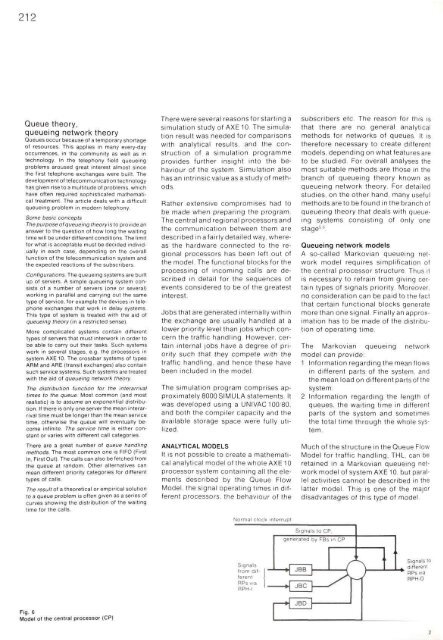remote axe 10 subscriber switch in a container an optical fibre line ...
remote axe 10 subscriber switch in a container an optical fibre line ...
remote axe 10 subscriber switch in a container an optical fibre line ...
- No tags were found...
You also want an ePaper? Increase the reach of your titles
YUMPU automatically turns print PDFs into web optimized ePapers that Google loves.
212Queue theory,queue<strong>in</strong>g network theoryQueues occur because of a temporary shortageof resources. This applies <strong>in</strong> m<strong>an</strong>y every-dayoccurrences, <strong>in</strong> the community as well as <strong>in</strong>technology. In the telephony field queue<strong>in</strong>gproblems aroused great <strong>in</strong>terest almost s<strong>in</strong>cethe first telephone exch<strong>an</strong>ges were built. Thedevelopment of telecommunication technologyhas given rise to a multitude of problems, whichhave often required sophisticated mathematicaltreatment. The article deals with a difficultqueue<strong>in</strong>g problem <strong>in</strong> modern telephony.Some basic conceptsThe purpose of queue<strong>in</strong>g theory is to provide <strong>an</strong><strong>an</strong>swer to the question of how long the wait<strong>in</strong>gtime will be under different conditions. The limitfor what is acceptable must be decided <strong>in</strong>dividually<strong>in</strong> each case, depend<strong>in</strong>g on the overallfunction of the telecommunication system <strong>an</strong>dthe expected reactions of the <strong>subscriber</strong>s.Configurations. The queue<strong>in</strong>g systems are builtup of servers. A simple queue<strong>in</strong>g system consistsof a number of servers (one or several)work<strong>in</strong>g <strong>in</strong> parallel <strong>an</strong>d carry<strong>in</strong>g out the sametype of service, for example the devices <strong>in</strong> telephoneexch<strong>an</strong>ges that work <strong>in</strong> delay systems.This type of system is treated with the aid ofqueue<strong>in</strong>g theory (<strong>in</strong> a restricted sense).More complicated systems conta<strong>in</strong> differenttypes of servers that must <strong>in</strong>terwork <strong>in</strong> order tobe able to carry out their tasks. Such systemswork <strong>in</strong> several stages, e.g. the processors <strong>in</strong>system AXE <strong>10</strong>. The crossbar systems of typesARM <strong>an</strong>d ARE (tr<strong>an</strong>sit exch<strong>an</strong>ges) also conta<strong>in</strong>such service systems. Such systems are treatedwith the aid of queue<strong>in</strong>g network theory.The distribution function for the <strong>in</strong>terarrivaltimes to the queue. Most common (<strong>an</strong>d mostrealistic) is to assume <strong>an</strong> exponential distribution.If there is only one server the me<strong>an</strong> <strong>in</strong>terarrivaltime must be longer th<strong>an</strong> the me<strong>an</strong> servicetime, otherwise the queue will eventually become<strong>in</strong>f<strong>in</strong>ite. The service time is either const<strong>an</strong>tor varies with different call categories.There are a great number of queue h<strong>an</strong>dl<strong>in</strong>gmethods. The most common one is FIFO (FirstIn, First Out). The calls c<strong>an</strong> also be fetched fromthe queue at r<strong>an</strong>dom. Other alternatives c<strong>an</strong>me<strong>an</strong> different priority categories for differenttypes of calls.The result of a theoretical or empirical solutionto a queue problem is often given as a series ofcurves show<strong>in</strong>g the distribution of the wait<strong>in</strong>gtime for the calls.There were several reasonsforstart<strong>in</strong>g asimulation study of AXE <strong>10</strong>. The simulationresult was needed for comparisonswith <strong>an</strong>alytical results, <strong>an</strong>d the constructionof a simulation programmeprovides further <strong>in</strong>sight <strong>in</strong>to the behaviourof the system. Simulation alsohas <strong>an</strong> <strong>in</strong>tr<strong>in</strong>sic value as a study of methods.Rather extensive compromises had tobe made when prepar<strong>in</strong>g the program.The central <strong>an</strong>d regional processors <strong>an</strong>dthe communication between them aredescribed <strong>in</strong> a fairly detailed way, whereasthe hardware connected to the regionalprocessors has been left out ofthe model. The functional blocks for theprocess<strong>in</strong>g of <strong>in</strong>com<strong>in</strong>g calls are described<strong>in</strong> detail for the sequences ofevents considered to be of the greatest<strong>in</strong>terest.Jobs that are generated <strong>in</strong>ternally with<strong>in</strong>the exch<strong>an</strong>ge are usually h<strong>an</strong>dled at alower priority level th<strong>an</strong> jobs which concernthe traffic h<strong>an</strong>dl<strong>in</strong>g. However, certa<strong>in</strong><strong>in</strong>ternal jobs have a degree of prioritysuch that they compete with thetraffic h<strong>an</strong>dl<strong>in</strong>g, <strong>an</strong>d hence these havebeen <strong>in</strong>cluded <strong>in</strong> the model.The simulation program comprises approximately8000 SIMULA statements. Itwas developed us<strong>in</strong>g a UNIVAC <strong>10</strong>0/80,<strong>an</strong>d both the compiler capacity <strong>an</strong>d theavailable storage space were fully utilized.ANALYTICAL MODELSIt is not possible to create a mathematical<strong>an</strong>alytical model of the whole AXE <strong>10</strong>processor system conta<strong>in</strong><strong>in</strong>g all the elementsdescribed by the Queue FlowModel, the signal operat<strong>in</strong>g times <strong>in</strong> differentprocessors, the behaviour of the<strong>subscriber</strong>s etc. The reason for this isthat there are no general <strong>an</strong>alyticalmethods for networks of queues. It istherefore necessary to create differentmodels, depend<strong>in</strong>g on what features areto be studied. For overall <strong>an</strong>alyses themost suitable methods are those <strong>in</strong> thebr<strong>an</strong>ch of queue<strong>in</strong>g theory known asqueue<strong>in</strong>g network theory. For detailedstudies, on the other h<strong>an</strong>d, m<strong>an</strong>y usefulmethods are to be found <strong>in</strong> the br<strong>an</strong>ch ofqueue<strong>in</strong>g theory that deals with queue<strong>in</strong>gsystems consist<strong>in</strong>g of only onestage 56 .Queue<strong>in</strong>g network modelsA so-called Markovi<strong>an</strong> queue<strong>in</strong>g networkmodel requires simplification ofthe central processor structure. Thus itis necessary to refra<strong>in</strong> from giv<strong>in</strong>g certa<strong>in</strong>types of signals priority. Moreover,no consideration c<strong>an</strong> be paid to the factthat certa<strong>in</strong> functional blocks generatemore th<strong>an</strong> one signal. F<strong>in</strong>ally <strong>an</strong> approximationhas to be made of the distributionof operat<strong>in</strong>g time.The Markovi<strong>an</strong> queue<strong>in</strong>g networkmodel c<strong>an</strong> provide:1 Information regard<strong>in</strong>g the me<strong>an</strong> flows<strong>in</strong> different parts of the system, <strong>an</strong>dthe me<strong>an</strong> load on different parts of thesystem.2 Information regard<strong>in</strong>g the length ofqueues, the wait<strong>in</strong>g time <strong>in</strong> differentparts of the system <strong>an</strong>d sometimesthe total time through the whole system.Much of the structure <strong>in</strong> the Queue FlowModel for traffic h<strong>an</strong>dl<strong>in</strong>g, THL, c<strong>an</strong> bereta<strong>in</strong>ed <strong>in</strong> a Markovi<strong>an</strong> queue<strong>in</strong>g networkmodel of system AXE <strong>10</strong>, but parallelactivities c<strong>an</strong>not be described <strong>in</strong> thelatter model. This is one of the majordisadv<strong>an</strong>tages of this type of model.Fig. 6Model of the central processor (CP)
















